Food and Drink: Special Occasion Foods
National and Public Holidays
Independence Day

India’s Independence Day, celebrated on August 15, is a day of national pride, commemorating the country’s freedom from British rule in 1947. Public ceremonies, flag-hoisting events, and cultural programs mark the day. While the food traditions vary by region, Independence Day often includes family gatherings featuring dishes such as biryani (spiced rice and meat), chole bhature (spiced chickpeas with fried bread), and sweet treats including gulab jamun (fried dough balls) and jalebi (funnel cake-like treat). These foods reflect India’s diverse culinary heritage, with meals often shared in community events to celebrate the unity and freedom of the nation.
Religious and Spiritual Occasions
Diwali
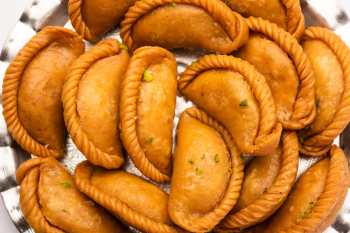
Diwali, the festival of lights, is one of India’s most important religious festivals, symbolizing the victory of light over darkness and good over evil. The focus of the celebration is on lighting oil lamps, exchanging gifts, and sharing food with family and friends. Indians snack on mithai (sweets) throughout the day, and it is customary to exchange boxes filled with mithai, nuts, and dried fruit with family and friends. Gujiyas (fried dumplings filled with milk solids and nuts) are a mainstay of the holiday, as are the sweet doughnut holes called gulab jamun or laddu. An array of milk fudge, including kesar peda and barfi, also is available. Celebrants also enjoy flavorful drinks, such as saffron syrup drinks, thandai (a cold drink made with milk, almonds, rose petals, and seeds), and bhang (a drink prepared with edible cannabis). The sweets are made in abundance and shared with neighbors and relatives, reflecting the festival’s spirit of generosity and happiness.
Eid al-Fitr
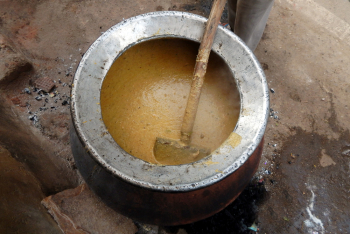
Eid al-Fitr marks the end of Ramadan, the Islamic holy month of fasting. The celebration is centered around a large feast known as the Eid meal, which typically includes dishes such as biryani (spiced rice and meat), haleem (a slow-cooked stew made with meat, lentils, and wheat), and kebabs. Desserts, including seviyan (vermicelli pudding) and phirni (rice pudding), also are enjoyed. The food at Eid is meant to celebrate the end of fasting, with meals shared in large family gatherings and community events, symbolizing gratitude and togetherness.
Holi
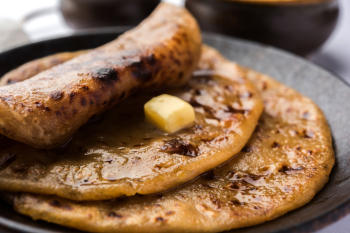
Holi is known as the festival of colors because it marks the beginning of spring and is celebrated by throwing vibrantly colored rub gulaal—made from flowers, spices, or dyed cornstarch—over celebrants. The festival is known for its brightly colored powders, water fights, and joyous atmosphere. It is celebrated at large festivals and in homes, with chaat (snacks) abundant at both venues. Families eat a feast of various regional dishes to celebrate the forthcoming bounty of spring. Traditional foods for Holi include gujiya (fried dumplings filled with milk solids and nuts), thandai (a spiced milk drink), kanji-ke-bade (lentil cakes), and dahi bhalla (lentil dumplings in yogurt). A popular seasonal dessert is puran poli, a sweet flatbread filled with lentils and fried in jiggery. Sweets and snacks are shared among friends and family, and the food reflects the playful and festive nature of the occasion, where meals are integral to celebrating togetherness and joy.
Navratri
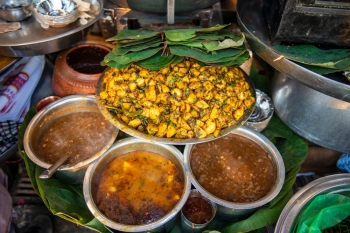
Navratri, a nine-day Hindu festival dedicated to the goddess Durga, is marked by fasting, prayers, and celebrations. During the festival, many devotees follow special dietary restrictions, avoiding grains, onion, and garlic. Foods such as sabudana khichdi (tapioca pearls cooked with peanuts), kuttu ki puri (buckwheat flour bread), and aloo sabzi (potato curry) are commonly prepared. The meals during Navratri are simple yet flavorful, focusing on ingredients that are allowed during the fast. These foods reflect devotion, purity, and the spiritual focus of the festival.
Life Milestones and Personal Celebrations
Weddings
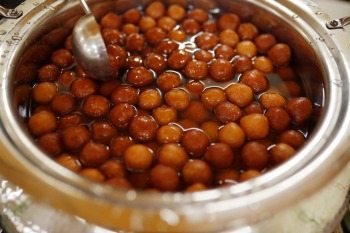
Indian weddings are grand celebrations that vary by region, but food plays a significant role in all of them. A typical Indian wedding feast includes a variety of dishes, such as paneer tikka (chunks of marinated paneer grilled in a tandoor), murgh makhani (buttery chicken), dal makhani (lentils cooked with butter and cream), and biryani (spiced rice and meat), along with assorted breads, including naan and paratha. Desserts such as gulab jamun (fried dough balls), rasgulla (balls of curdled milk in syrup), and jalebi (funnel cake-like treat) are commonly served. In South Indian weddings, dishes such as sambar (a lentil-based vegetable stew), dosa (crepes), and payasam (rice pudding) are popular. The wedding feast symbolizes abundance, prosperity, and the union of families, with food being central to the celebration.
Birthdays

Birthdays in India are joyous occasions marked by special meals, cake-cutting ceremonies, and family gatherings. The birthday meal often features the birthday person’s favorite dishes, which can range from traditional foods such as biryani (spiced rice and meat) and chole bhature (spicy chickpea sauce with fluffy fried bread) to modern favorites, including pizza or pasta. The birthday cake is typically a highlight, decorated with candles and often paired with sweets such as rasmalai or ladoos. The food served at birthday celebrations reflects indulgence, joy, and the importance of family, with meals designed to bring people together in celebration.
Cultural and Regional Festivals
Pongal

Pongal, celebrated in Tamil Nadu, is a harvest festival that honors the sun god for a bountiful crop. The main dish served during the festival is pongal, a rice dish cooked with lentils, ghee, and spices, often sweetened with jaggery and flavored with cardamom. Other traditional dishes include vadai (fried lentil fritters) and payasam (rice pudding). The food during Pongal reflects gratitude for the harvest, and the meals are typically prepared with freshly harvested rice and shared with family, friends, and neighbors as part of the celebrations.
Onam
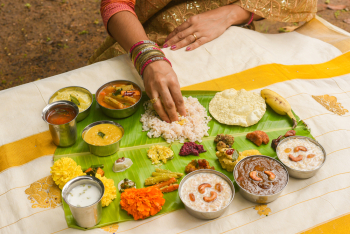
Onam is the harvest festival of Kerala, celebrated with the grand Onam sadhya, a vegetarian feast served on a banana leaf. The sadhya includes a variety of dishes, such as avial (a mixed vegetable curry), sambar (a lentil-based vegetable stew), rasam, pachadi (a yogurt-based dish), and banana chips. Desserts, including payasam (a sweet pudding), also are part of the meal. The food served during Onam symbolizes the abundance of the harvest season and is enjoyed in a communal setting, bringing together families and communities in celebration.
Durga Puja
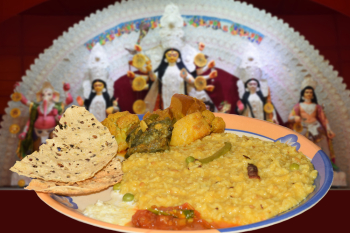
Durga Puja is a major five- to 10-day Indian holiday that celebrates the many-armed warrior goddess Durga. In commemoration of Durga’s defeat of evil during a 10-day battle, devotees fast for nine days and hold a festival on the day of victory, Vijayadashami. The ritual fasting is broken daily with a large Bengali-style meal called a bhog. Temporary veneration sites called pandals are built to celebrate Durga and make the offering of bhog that is later distributed to worshippers; it is considered a great honor to eat food that was offered to Durga. The bhog is typically served individually on a large platter and includes rice, lentils, mixed vegetable sides, kheer (rice pudding), chutney, and potatoes. Along with bhog foods, other traditional foods served include khichuri (a spiced rice and lentil dish) and various sweets such as rasgulla (balls of curdled milk in syrup) and sandesh. Street food stalls also offer popular Bengali snacks, including kachori and puchka (pani puri). The food during Durga Puja reflects devotion, celebration, and the rich culinary traditions of Bengal, with meals shared in both family settings and public feasts.
Copyright © 1993—2025 World Trade Press. All rights reserved.

 India
India